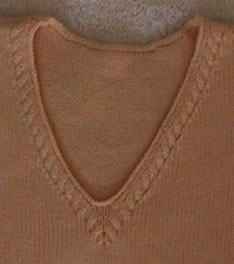Navigate my site!
My site is supported by donations. Please
click the paypal logo to make a $3 donation.
 This
page describes how to make the Cable Trim V Neckline which I used on a
vest.
This elegant technique can be created on any knitting machine. Because
the cables are hand turned, the level of difficulty is
"intermediate".
An elastic yarn, like wool or acrylic, is recommended. I used Jagger
Spun Superfine Merino. This
page describes how to make the Cable Trim V Neckline which I used on a
vest.
This elegant technique can be created on any knitting machine. Because
the cables are hand turned, the level of difficulty is
"intermediate".
An elastic yarn, like wool or acrylic, is recommended. I used Jagger
Spun Superfine Merino.
To create my neckline, I adapted this technique very slightly from "The Neckline Encyclopedia" written by Buerkel and Michler translated to English by Stitt. My adaptation permits a slightly curved shaping for the V neck decreases, which I find more flattering than a straight decrease. It can also be applied to very deep or very shallow V necks. This particular V-neck is shallower than permissible following the books directions. I really love this neckline. So, I'll be making it again. To help myself next time, I made wrote a small program to recalculate row number. If you scroll down, you can use the program too. If you don't want to get mixed up and accidentally "modify" the neck design, write the cable turn rows on row/stitch table on your The Knitting Fiend directions. Historical Note: I knit to the base of the cables at 10 pm on Monday September 10, 2001. I figured I'd go to sleep and begin the somewhat complicated neck shaping and cable turning in the morning. I worked on the neck all day Tuesday, September 11, 2001. I ripped it out and reshaped the neck Wednesday, September 12, 2001. |